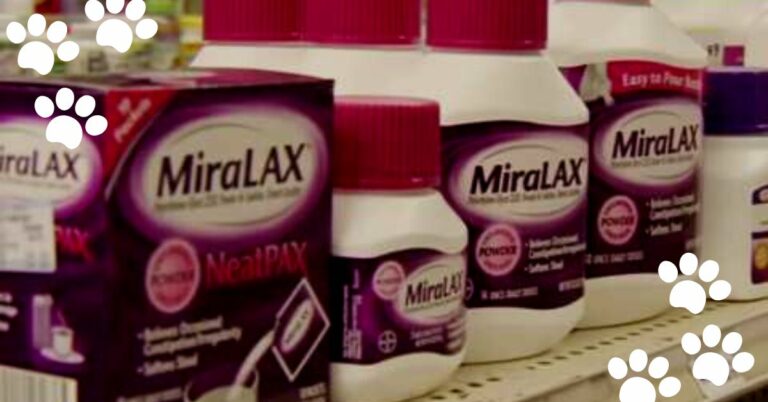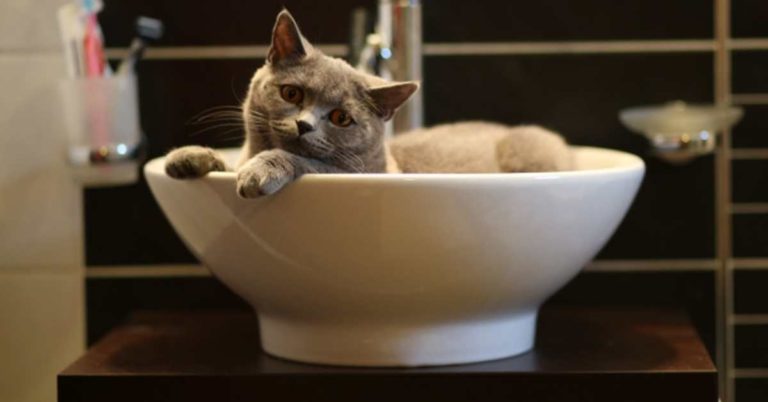Is Aglaonema Toxic to Cats? (Symptoms & Treatments)
Yes, Aglaonema plants are toxic to cats as it contains calcium oxalate crystals. Ingesting a part of this plant can cause vomiting, difficulty swallowing, and intense irritation in the mouth and throat.
In some cases, it can even lead to difficulty in breathing and other serious symptoms. Moreover, ingestion of the plant sap may also cause skin irritation in cats and other animals.
Here in this blog post, I’ll discuss the effects of aglaonema on cats in detail and provide preventive measures for pet owners to take. So, keep reading if you want to learn more!
Why Aglaonema is Toxic to Cats? (Explained)
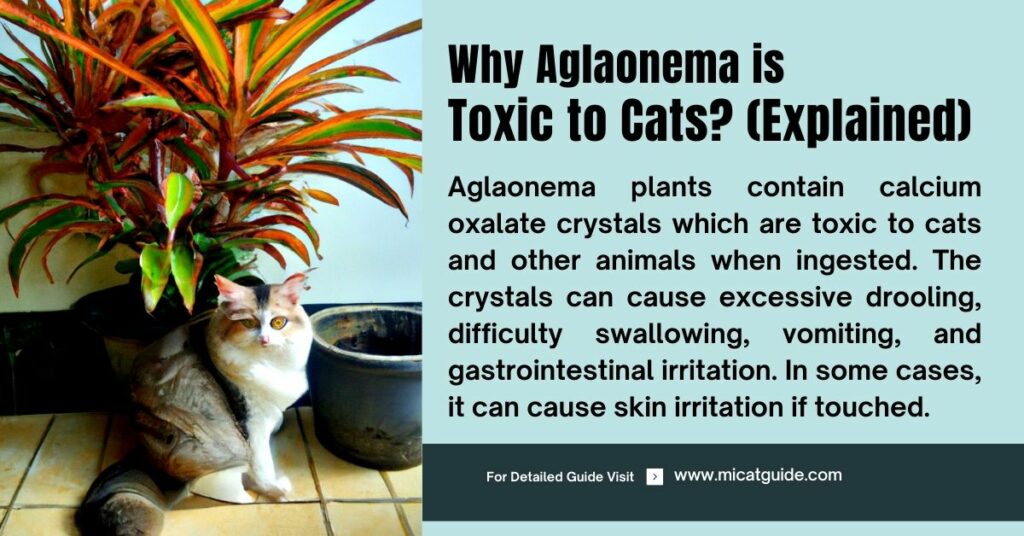
Cats are adorable, curious creatures that will often nibble on plants in your home. While many plants are harmless to cats, others can be dangerous, even deadly. One such plant is Aglaonema, also known as Chinese Evergreen.
Here I’ll discuss why Aglaonema is toxic to cats and what you should do if your cat ingests this plant.
1. Aglaonema Contains Calcium Oxalate Crystals
Aglaonema plants are popular among indoor gardeners because they are easy to care for and come in a variety of colors. However, recent studies have shown that Aglaonema plants are toxic to cats and contain calcium oxalate crystals.
In a study published in the journal ” Veterinary and Human Toxicology “, researchers evaluated the toxicity of Aglaonema plants in cats. They found that all of the cats who ate parts of the plant developed signs of poisoning, including vomiting, diarrhea, and difficulty breathing.
The study’s authors note that the calcium oxalate crystals found in Aglaonema plants can cause serious health problems in cats, including damage to the kidneys and liver. They advise cat owners to avoid keeping these plants in their home if they have a feline companion.
You can also read: Is Alocasia Toxic to Cats?
2. Ingesting Aglaonema Can Cause Severe Irritation
In addition to the presence of calcium oxalate crystals, ingestion of any part of the Aglaonema plant can cause intense irritation in the mouth and throat of cats. This irritation can lead to difficulty swallowing and even gagging as the throat swells.
In some cases, this irritation can progress to more serious symptoms such as difficulty breathing and even death. Therefore, it is important to take any signs of poisoning seriously and seek veterinary help immediately.
3. Aglaonema Sap May Also Cause Skin Irritations
Aside from being toxic when ingested, the sap of Aglaonema plants can also cause skin irritation. In a study published in the journal “Veterinary Dermatology“, researchers evaluated the effects of Aglaonema sap on cats and found that it can cause skin irritation, redness, and even blistering.
The study’s authors recommend avoiding contact with the sap of this plant to prevent any potential skin reactions in cats.
Symptoms of Aglaonema Poisoning on Cats
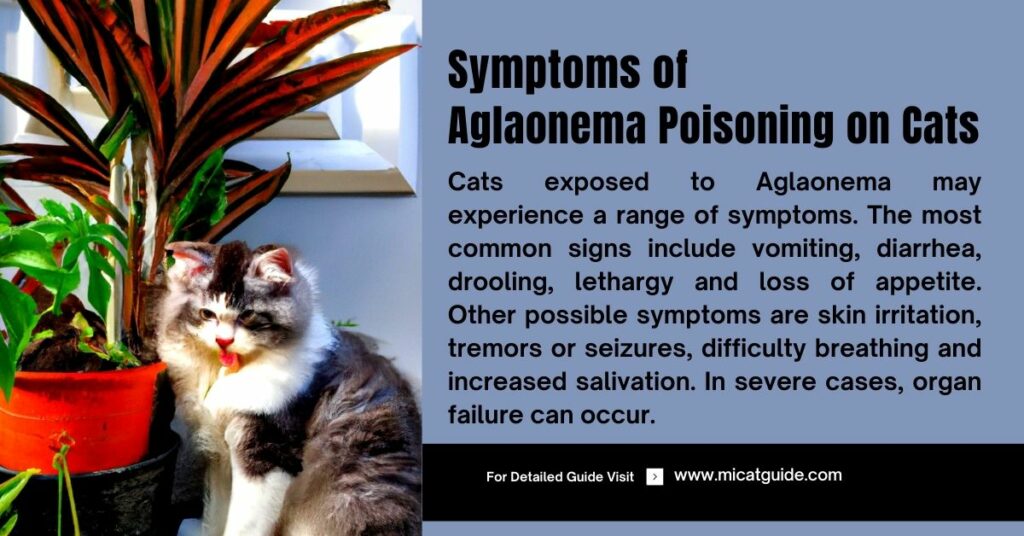
I know this information can be scary, so it’s important to know the signs of Aglaonema poisoning in cats:
- Vomiting
- Difficulty swallowing
- Intense irritation in the mouth and throat
- Difficulty breathing
- Redness and blistering of the skin
Symptoms typically appear within a few hours of ingestion and may include vomiting, diarrhea, lethargy, and lack of appetite. In severe cases, the toxins can cause liver damage and failure. If you suspect your cat has ingested aglaonema, contact your veterinarian or local animal hospital immediately.
What to Do if Your Cat Ingests Aglaonema?
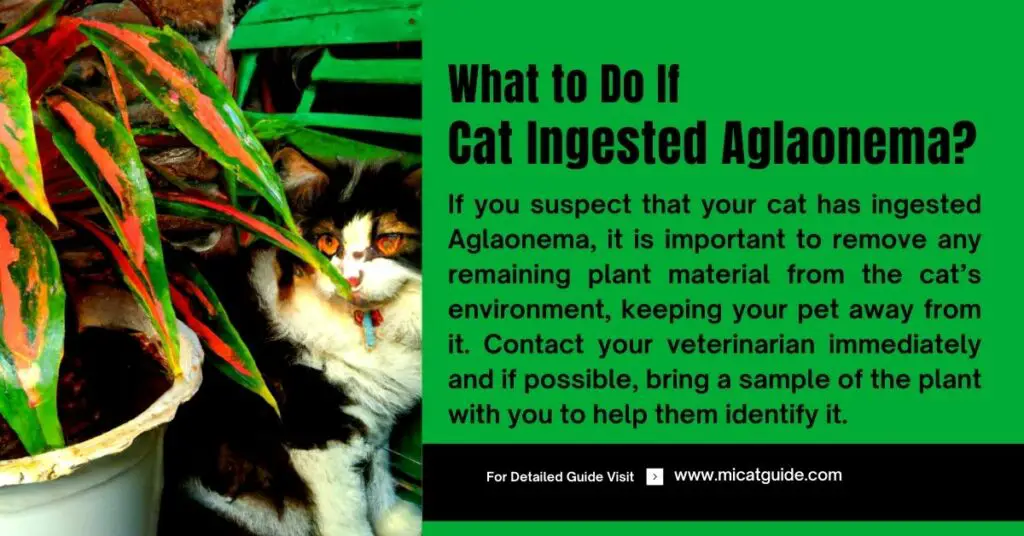
Here I’ll discuss what pet owners should do if their cat ingests Aglaonema:
1. Remove Any Remaining Plant Material
If you suspect that your cat may have eaten any part of an Aglaonema plant, remove any remaining material from your home. This will help prevent further accidental ingestion and reduce the risk of poisoning.
2. Contact Your Veterinarian
If you think that your cat has ingested any part of the Aglaonema plant, contact your veterinarian or local animal hospital immediately. They will be able to advise you on the best course of action and can provide medical treatment if necessary.
3. Monitor Your Cat Closely
If your cat has ingested Aglaonema, it is important to monitor them closely for any signs of poisoning. Symptoms such as vomiting, difficulty swallowing, and intense irritation in the mouth and throat should be reported to your veterinarian right away.
In severe cases, contact your vet immediately or take your pet to an animal hospital for further evaluation and treatment.
4. Avoid Contact with The Sap
Finally, it’s important to avoid contact with the sap of Aglaonema plants as this can cause skin irritation in cats. If you come into contact with the sap, it is important to thoroughly wash your hands and any affected areas of your cat.
How to Treat Aglaonema Poisoning in Cats?
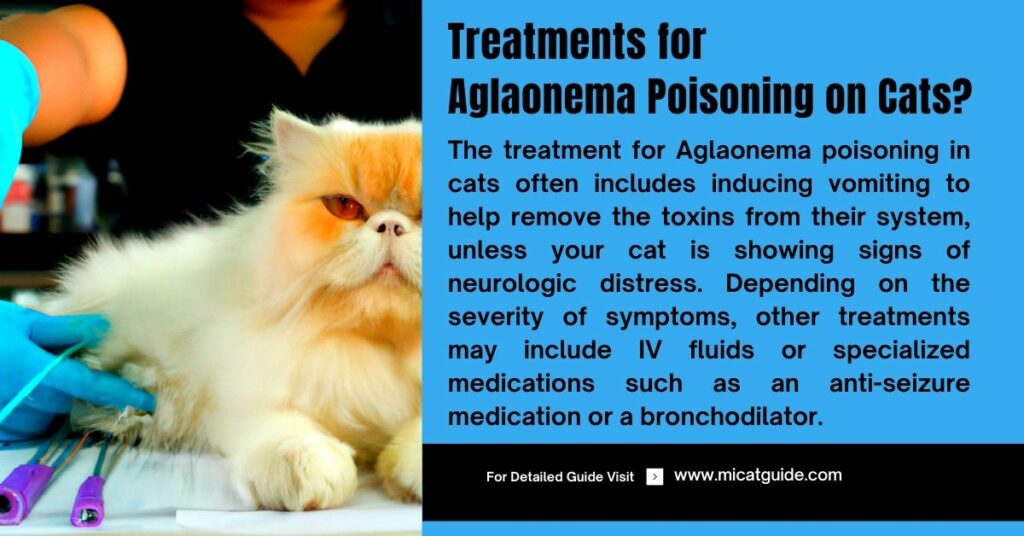
From my own experience and from speaking to other pet owners, the treatment for Aglaonema poisoning will depend on the severity of your cat’s symptoms and the amount of plant material they have ingested. Treatment may include:
1. Decontamination and stabilization
If your cat is showing signs of poisoning, your veterinarian may administer activated charcoal to help absorb the toxins in their stomach and reduce the amount of toxin absorbed into their system. They may also provide fluids to help flush the toxins out of their body.
2. Medication
Your vet may prescribe medications such as antiemetics to stop vomiting, antacids to reduce irritation in the mouth or throat, and antibiotics to prevent infection.
3. Monitoring
Your vet will likely want to monitor your cat’s vital signs, including temperature, heart rate, and respiratory rate. They will also do regular blood tests throughout treatment to assess any damage that has been done by the ingestion of Aglaonema plants.
It’s important to note that Aglaonema poisoning can be life-threatening, so it is best to contact your veterinarian right away if you suspect your cat has ingested any part of this plant. With prompt treatment, cats can make a full recovery from Aglaonema poisoning.
How to Keep Cats Safe from Aglaonema Poisoning?
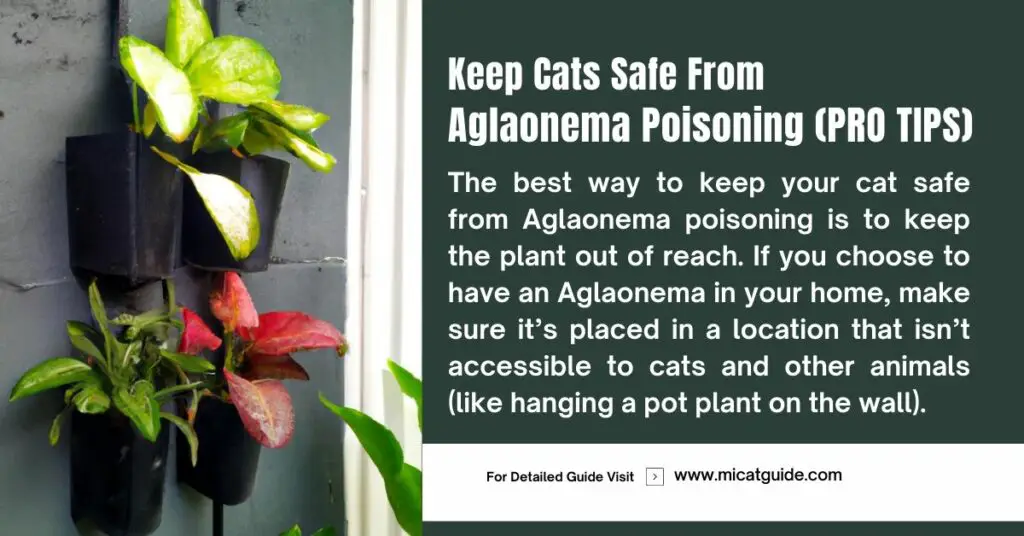
After reading about the dangers of Aglaonema poisoning, you may be wondering what steps you can take to keep your cat safe from this dangerous plant. Here are some tips for preventing Aglaonema poisoning in cats:
1. Keep Plants Out of Reach
Whenever possible, keep Aglaonema plants and any other potentially poisonous plant out of your cat’s reach. This may mean keeping them in an area where your cat can’t access them, such as on top of a tall shelf or in a room that your cat doesn’t go into.
Need more ideas on keep plants out of reach from your cats? Here I’ll try to give you more insight from my experience with cats.
a. Hang a Pot of Plant On The Wall
If you have an Aglaonema plant, try hanging it on the wall. Not only will this keep your cat away from the plant, but it will also add an extra decorative touch to your home.
b. Use a Cat Gate
If there’s an area in your house where you keep plants that are potentially poisonous to cats, consider installing a gate or barrier to prevent them from accessing these areas. You can purchase cat gates at most pet stores or online.
c. Choose Non-Toxic Plants
Finally, if you want to add some greenery to your home without the fear of poisoning your cat, try choosing plants that are known to be non-toxic to cats, such as spider plants and cacti.
2. Monitor Your Cat’s Activity
It’s also important to monitor your cat’s activity around plants. If you notice that your cat is getting too close to a potentially poisonous plant, it’s best to remove the plant or keep them away from it.
3. Educate Yourself on Toxic Plants
Finally, make sure you familiarize yourself with the plants that may be toxic to cats, including Aglaonema. Knowing which plants are dangerous and taking steps to keep them out of your cat’s reach can help keep your pet safe.
By following these tips, you can help ensure that your cat is safe from the dangers of Aglaonema poisoning. Remember, prevention is key when it comes to protecting your pet from harm. With the right precautions, you can keep your cat safe and healthy.
My Final Thoughts
Aglaonema is a beautiful and common houseplant, however it can be dangerous to cats if ingested. While the symptoms of Aglaonema poisoning can be severe, most cats make a full recovery with prompt medical treatment.
As a pet owner, it’s important to educate yourself on the plants that may be toxic to your pets and take steps to keep them away from these plants. By following the tips outlined above and staying vigilant, you can help keep your cat safe from the dangers of Aglaonema poisoning.
Thank you for taking the time to learn more about Aglaonema poisoning in cats. I hope this article has been helpful in providing you with information on how to keep your cat safe from this potentially dangerous plant. Good luck!

